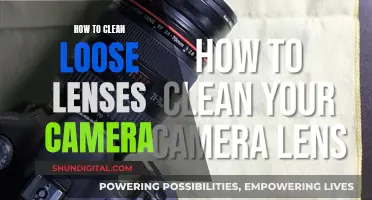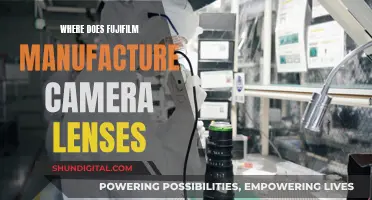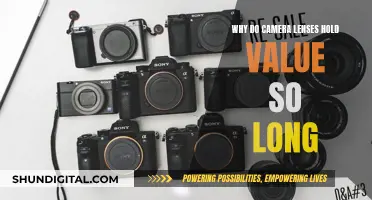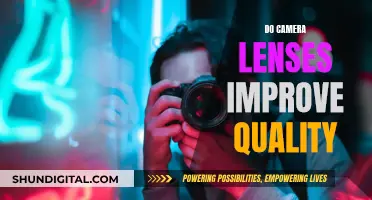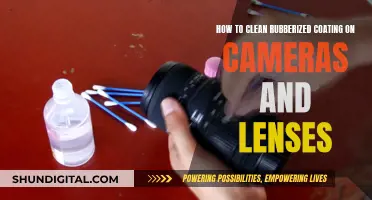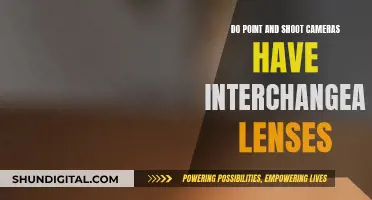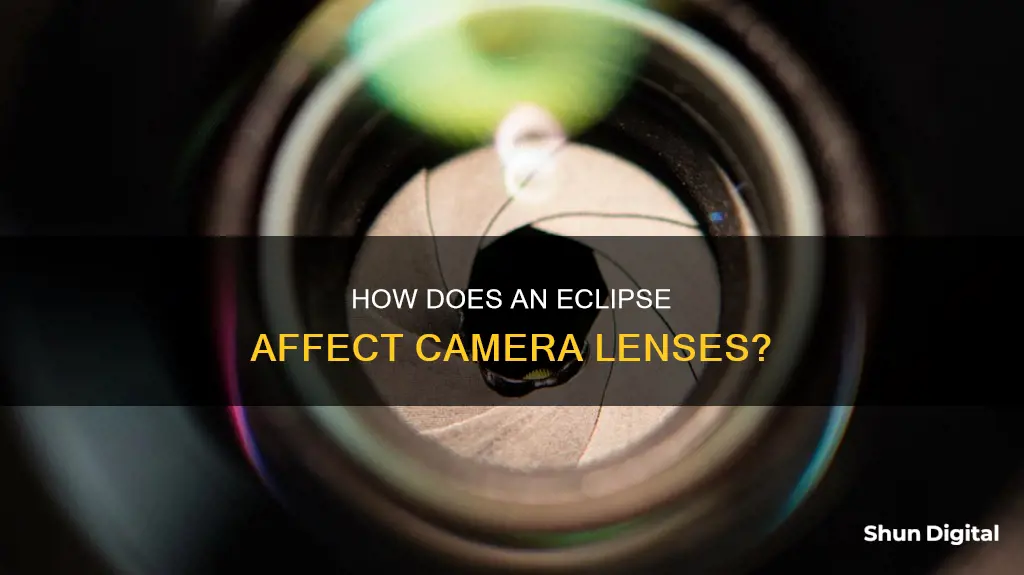
The upcoming total solar eclipse will be a once-in-a-lifetime sight for many, and while it may be tempting to capture the moment on camera, experts advise against it. Pointing a camera or phone at the sun during an eclipse may cause irreversible damage to the device, especially without the proper equipment.
| Characteristics | Values |
|---|---|
| Can an eclipse damage camera lenses? | Yes, pointing a camera lens directly at an eclipse can damage the image sensor. |
| What about phone cameras? | Phone camera sensors can also be damaged by pointing them directly at an eclipse. |
| How can you protect your camera/phone camera? | Use a solar filter or eclipse glasses over the lens. |
| When can you remove the filter? | During totality, when the sun is completely blocked by the moon, it is safe to remove filters and glasses. |
| What kind of camera is best for photographing an eclipse? | A DSLR or mirrorless camera with full manual control, a super-telephoto lens (at least 200mm), a tripod, and a shutter release. |
What You'll Learn

Using a phone camera to capture an eclipse
The Dangers
It is important to note that experts, including NASA, warn against pointing your phone camera directly at the sun to take photos of an eclipse. Doing so could permanently damage your phone's camera sensor. This is because phone cameras are not equipped with the resolution or protective filters needed for safe and successful solar photography.
Protective Measures
If you want to capture an eclipse with your phone camera, it is recommended to use a pair of ISO 12312-2-certified eclipse glasses or a sun filter in front of your phone's lens when photographing the sun during the eclipse, except for during totality when it is safe to remove the protective gear.
Photography Tips
- Keep your phone settings basic and don't zoom in. A wide shot will likely work better and show the surrounding environment.
- Try using the focus lock feature on your phone by tapping and holding the screen until you see the yellow AE/AF LOCK alert.
- Adjust your exposure by dragging your finger up and down near the sun icon to increase or decrease brightness.
- Use a tripod or your phone's timer mode to minimise movement and get a clear shot.
- Use burst mode during totality to capture as many photos as possible and try to get the special "diamond ring effect".
- Don't forget to document the moment beyond the sky. Take pictures of your surroundings, like people's reactions and the eclipse's effect on the environment, such as crescent-shaped patterns of light on the ground.
Final Reminders
Remember to always protect your eyes when viewing an eclipse. Do not look directly at the sun without proper eye protection, such as eclipse glasses that meet international safety standards. Enjoy the eclipse and capture some memorable shots!
Compatibility of Pentax Lenses with Fujica Cameras
You may want to see also

The dangers of pointing a camera lens at the sun
Pointing a camera lens at the sun can cause permanent damage to the device, especially if a magnifying lens attachment is used. The sun's rays can overwhelm and potentially break the image sensor in your camera or phone.
NASA has warned people not to point phone cameras directly at the sun to take photos of an eclipse. They suggest holding a pair of eclipse glasses in front of the camera lens when photographing the sun.
Adam Gallardo, manager at B&C Camera in Las Vegas, agrees, stating that it's "not a good idea to point cameras or phones directly at the sun without the proper equipment". The "proper equipment" in this case is a solar filter, which can be purchased inexpensively at many national retailers.
To summarise, pointing a camera lens at the sun can result in two types of damage: physical harm to the camera or phone sensor, and potential eye damage to the photographer if proper precautions are not taken. It is important to always use the necessary protective equipment, such as solar filters or eclipse glasses, when attempting to capture images of the sun.
Camera Lenses: Scratch-Resistant or Not?
You may want to see also

The use of solar filters to protect camera lenses
Solar filters are essential to protect camera lenses from damage during an eclipse. The intense sunlight and heat can permanently damage the sensitive image sensor of a camera, and the risk is especially high when using magnifying lenses such as zoom lenses, telescopes, or binoculars.
There are several types of solar filters available, including metal on glass, aluminized polyester film, and black polymer. These filters can render the sun as white or impart a yellow, orange, or bluish tint. All are effective, so the choice depends on your preference and budget. It is important to attach the filter securely to the front of the lens, ensuring it won't come off if bumped but can still be removed easily during totality.
It is recommended to use certified solar filters designed specifically for visual viewing or photography. While ND filters can be stacked to achieve the necessary 16-stop reduction, this is not recommended as it may damage the camera and is unsafe for your eyes. Only use ND filters if they are certified solar filters and have a wide spectral response, blocking both visible and infrared light.
During totality, when the moon completely blocks the sun, it is safe to remove the solar filter. However, for most of the eclipse, filters are necessary to protect your camera and your eyes.
Understanding Camera Lenses: Power of Convergence and Divergence
You may want to see also

The effects of magnifying lenses on camera sensors
A magnifying glass is a convex lens that is used to produce a magnified image of an object. The lens is usually mounted in a frame with a handle. The magnification of a magnifying glass depends on where it is placed between the user's eye and the object being viewed, and the total distance between them. The magnifying power is the ratio of the sizes of the images formed on the user's retina with and without the lens.
A camera lens works in a similar way to a magnifying glass. There are two basic types of simple lenses: positive and negative. A positive convex lens causes parallel light rays entering one side of the lens to converge at a focal point on the other side. A negative concave lens causes parallel rays to emerge moving away from each other, as though they came from a common focal point on the other side of the lens. These two basic shapes are used to make compound lenses, which use different combinations of lenses to herd light rays into the corrals of film, eyes, and imaging sensors.
The sun can damage image sensors like those in cellphone cameras. Phones and cameras can often handle short snaps of the sun during sunrise or sunset or as part of the background of other photos. However, pointing them directly at the sun, especially for extended periods, risks potentially catastrophic damage to the sensitive image sensor. This is especially true if a magnifying lens attachment is used. Protective filters are therefore important to protect camera sensors when using magnifying lenses.
How Lenses Transform Your Camera's Vision
You may want to see also

The safety of photographing an eclipse during totality
To protect your camera equipment during the partial phases of the eclipse, it is essential to use a solar filter over the lens. This will prevent damage to the camera's sensor, which can occur if a telephoto lens is pointed at the sun without protection. The intensity of sunlight can be magnified by a telephoto lens, and in extreme cases, it can melt the sensor. Regular camera filters are insufficient, and it is recommended to use specialist solar filters or neutral density filters of 16-stop strength or above.
Additionally, it is advised to use a tripod to stabilize the camera and avoid blurry images. Practicing beforehand and understanding your camera settings are also crucial to capturing incredible shots during the brief totality period.
Motorized Telescoping Lenses: Are They Reliable Camera Companions?
You may want to see also
Frequently asked questions
Experts advise against it. The sun's rays can overwhelm the sensors in your phone camera, causing damage.
The sun's rays can damage your camera's sensor. In some cases, a telephoto lens pointed at the sun without protection can melt your sensor.
You can use solar filters made for smartphones and camera lenses. You can also hold ISO-certified eclipse glasses in front of your camera lens.


